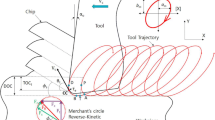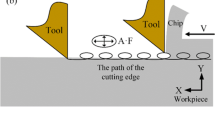Abstract
Bone cutting is an essential procedure of orthopedic surgery, while irreversible bone damage would be inevitably caused using the conventional cutting (CC) method. In this study, an ultrasonic vibration-assisted cutting (UVAC) method was applied in bone cutting to investigate the cutting performance, considering the cutting force and temperature rise, in comparison with CC. In addition, a finite element (FE) model was developed to investigate the cutting mechanism and the influence of a wide range of processing parameters on the performance of cutting bone. The results indicate that the proposed FE model shows good correlation with the experimental results for both cutting force and temperature. UVAC can significantly reduce the cutting force and increase the temperature in comparison with CC from the experimental and predicted results. The cutting force tends to decrease with the increasing vibrational parameters and decreasing cutting speed, while the temperature increases. The verified FE bone cutting model provides an efficient way to assist the optimization of the processing conditions in bone cutting operations.








Similar content being viewed by others
References
Alam, K., A. Ghafoor, and V. V. Silberschmidt. Analysis of forces and temperatures in conventional and ultrasonically-assisted cutting of bone. Adv. Mater. Res. 223:247–254, 2011.
Alam, K., M. Khan, and V. V. Silberschmidt. Analysis of forces in conventional and ultrasonically assisted plane cutting of cortical bone. Proc. Inst. Mech. Eng. Part H 227:636–642, 2013.
Alam, K., A. V. Mitrofanov, and V. V. Silberschmidt. Finite element analysis of forces of plane cutting of cortical bone. Comput. Mater. Sci. 46:738–743, 2009.
Augustin, G., S. Davila, K. Mihoci, T. Udiljak, D. S. Vedrina, and A. Antabak. Thermal osteonecrosis and bone drilling parameters revisited. Arch. Orthop. Trauma Surg. 128:71–77, 2008.
Babitsky, V. I., A. V. Mitrofanov, and V. V. Silberschmidt. Ultrasonically assisted turning of aviation materials: simulations and experimental study. Ultrasonics 42:81–86, 2004.
Brehl, D. E., and T. A. Dow. Review of vibration-assisted machining. Precis. Eng. 32:153–172, 2008.
Eriksson, A. R., and T. Albrektsson. Temperature threshold levels for heat-induced bone tissue injury: a vital-microscopic study in the rabbit. J. Prosthet. Dent. 50:101–107, 1983.
Giraud, J.-Y., S. Villemin, R. Darmana, J.-P. Cahuzac, A. Autefage, and J.-P. Morucci. Bone cutting. Clin. Phys. Physiol. Meas. 12:1–19, 1991.
Hosseini, P., G. M. Mundis, Jr, R. Eastlack, J. Pawelek, S. Nguyen, and B. A. Akbarnia. Is there a role for an ultrasonic bone-cutting device in adult spinal deformity: a safety and reproducibility study. Shafa Orthop. J. 3(3), 2016.
Huang, Y., S. Chen, and J. Tang. Analyses of rotating disc cutting of wood. Taiwan J. Sci. 18:263–271, 2003.
Kazim, S. F., S. A. Enam, and M. S. Shamim. Possible detrimental effects of neurosurgical irrigation fluids on neural tissue: an evidence based analysis of various irrigants used in contemporary neurosurgical practice. Int. J. Surg. 8:586–590, 2010.
Khambay, B. S., and A. D. Walmsley. Investigations into the use of an ultrasonic chisel to cut bone. Part 1. Forces applied by clinicians. J. Dent. 28:31–37, 2000.
Leclercq, P., C. Zenati, S. Amr, and D. M. Dohan. Ultrasonic bone cut part 1: state-of-the-art technologies and common applications. J. Oral Maxillofac. Surg. 66:177–182, 2008.
Li, X., W. Zhu, J. Wang, and Y. Deng. Optimization of bone drilling process based on finite element analysis. Appl. Therm. Eng. 108:211–220, 2016.
Mitrofanov, A. V., V. I. Babitsky, and V. V. Silberschmidt. Finite element analysis of ultrasonically assisted turning of Inconel 718. J. Mater. Process. Technol. 153–154:233–239, 2004.
Mitrofanov, A. V., V. I. Babitsky, and V. V. Silberschmidt. Thermomechanical finite element simulations of ultrasonically assisted turning. Comput. Mater. Sci. 32:463–471, 2005.
Patil, S., S. Joshi, A. Tewari, and S. S. Joshi. Modelling and simulation of effect of ultrasonic vibrations on machining of Ti6Al4V. Ultrasonics 54:694–705, 2014.
Plaskos, C., A. J. Hodgson, K. Inkpen, and R. W. McGraw. Bone cutting errors in total knee arthroplasty. J. Arthroplasty 17:698–705, 2002.
Rashad, A., A. Kaiser, N. Prochnow, I. Schmitz, E. Hoffmann, and P. Maurer. Heat production during different ultrasonic and conventional osteotomy preparations for dental implants. Clin. Oral Implants Res. 22:1361–1365, 2011.
Reilly, D. T., and A. H. Burstein. The mechanical properties of cortical bone. JBJS 56:1001–1022, 1974.
Sakuma, I., K. Mukaiyama, I. Iordachita, K. Matsumiya, E. Kobayashi, and H. Yano. A bone cutting device for rotational acetabular osteotomy (RAO) with a curved oscillating saw. Int. Congr. Ser. 1268:632–637, 2004.
Santiuste, C., M. Rodríguez-Millán, E. Giner, and H. Miguélez. The influence of anisotropy in numerical modeling of orthogonal cutting of cortical bone. Compos. Struct. 116:423–431, 2014.
Shamoto, E., and T. Moriwaki. Study on elliptical vibration cutting. CIRP Ann. Manuf. Technol. 43:35–38, 1994.
Shu, L., and N. Sugita, Analysis of fracture, force, and temperature in orthogonal elliptical vibration-assisted bone cutting. J. Mech. Behav. Biomed. Mater. 103:103599, 2020.
Shu, L., N. Sugita, M. Oshima, and M. Mitsuishi. Design and experimental force analysis of a novel elliptical vibration assisted orthopedic oscillating saw. Med. Eng. Phys. 54:22–31, 2018.
Stübinger, S., C. Landes, O. Seitz, H. F. Zeilhofer, and R. Sader. Ultraschallbasiertes knochenschneiden in der oralchirurgie: eine übersicht anhand von 60 patientenfällen. Ultraschall der Medizin 29:66–71, 2008.
Sugita, N., L. Shu, T. Shimada, M. Oshima, T. Kizaki, and M. Mitsuishi. Novel surgical machining via an impact cutting method based on fracture analysis with a discontinuum bone model. CIRP Ann. Manuf. Technol. 66:65–68, 2017.
Wang, Y., M. Cao, X. Zhao, G. Zhu, C. McClean, Y. Zhao, and Y. Fan. Experimental investigations and finite element simulation of cutting heat in vibrational and conventional drilling of cortical bone. Med. Eng. Phys. 36:1408–1415, 2014.
Zhang, X., A. Senthil Kumar, M. Rahman, C. Nath, and K. Liu. An analytical force model for orthogonal elliptical vibration cutting technique. J. Manuf. Process. 14:378–387, 2012.
Acknowledgments
The authors thank Dr. Fang from The University of Tokyo for advice and equipment support in the experiment.
Conflict of interest
No benefits in any form have been or will be received from a commercial party related directly or indirectly to the subject of this manuscript.
Author information
Authors and Affiliations
Corresponding author
Additional information
Associate Editor Mona Kamal Marei oversaw the review of this article.
Publisher's Note
Springer Nature remains neutral with regard to jurisdictional claims in published maps and institutional affiliations.
Rights and permissions
About this article
Cite this article
Ying, Z., Shu, L. & Sugita, N. Experimental and Finite Element Analysis of Force and Temperature in Ultrasonic Vibration Assisted Bone Cutting. Ann Biomed Eng 48, 1281–1290 (2020). https://doi.org/10.1007/s10439-020-02452-w
Received:
Accepted:
Published:
Issue Date:
DOI: https://doi.org/10.1007/s10439-020-02452-w




